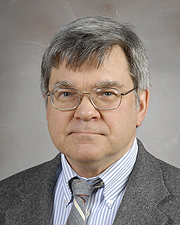
Richard J. Kulmacz, PhD
- Professor, Hematology
Biography
The goal of the proposed pilot project is to develop suitable quantitative assays to compare erythrocytes from sickle cell disease patients and normal individuals as to the level and functionality of duodenal cytochrome b (Dcytb), an important component of blood antioxidant defenses.
One of my lab’s ongoing interests is the mammalian cytochrome b561 family of proteins. These bis-heme cytochromes are integral membrane proteins that catalyze transmembrane transfer of an electron donated by ascorbic acid (Vitamin C). They are found in many tissues; some important pathophysiological functions are established for these cytochromes, others are still being discovered.
Recombinant cytochrome b561 proteins have turned out to be notably difficult to work with. My lab has led the way in overcoming these experimental hurdles, with indispensable ingenuity and effort coming from Dr. Wen Liu, a Co-Investigator on the proposed project. We have developed yeast and bacterial systems for expressing several mammalian cytochrome b561 proteins, including adrenal cyt b561 (Acytb) and duodenal cyt b (Dcytb), and have set up routine dot-blot assays for quantitating expression of the recombinant proteins. We have assembled a toolbox of procedures for solubilizing the cytochromes in native form for biochemical characterization in my lab and for biophysical characterization in collaboration with Dr. Ah-Lim Tsai, my longtime colleague in the Hematology Division.
Overall, I think that the expertise and experience outlined above provide a strong basis for my lab taking the lead on the proposed studies, for my role as PI, and for expecting a successful outcome from the project.